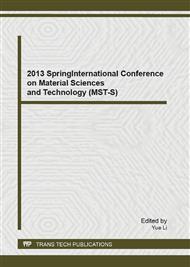[1]
C.C. Wang, F.L. Yang, L.F. Liu, Z.M. Fu, Y. Xue, J. Membr. Sci. 345 (2009) 223–232.
Google Scholar
[2]
Y. Zheng, H. Liu, P.V. Gurgel, R.G. Carbonell, J. Membr. Sci. 364 (2010) 362–371.
Google Scholar
[3]
J.Jin, Wei Jiang, Qiang shi,et,al. Fabrication of PP-g-PEGMA-g-heparin and its hemocompa tibility: From protein adsorption to anticoagulant tendency. Applied Surface Science, 2012. 258(15): pp.5841-5849.
DOI: 10.1016/j.apsusc.2012.02.113
Google Scholar
[4]
L.J Song. Biocompatibility of polypropylene non-woven fabric membrane via UV-induced graft polymerization of 2-acrylamido-2-methylpropane sulfonic acid. Applied Surface Science, 2011. 258(1): pp.425-430.
DOI: 10.1016/j.apsusc.2011.08.118
Google Scholar
[5]
X.M Li, S.F. Luan, H.W. Yang, et al. Surface modification of poly(styrene-b- -(ethylene-co-butylene)-b-styrene) elastomer via photo-initiated graft polymerization of poly(ethylene glycol). Applied Surface Science, 2012. 258(90): 2344–2349.
DOI: 10.1016/j.apsusc.2011.10.024
Google Scholar
[6]
J. Zhao, Q. Shi, L.G. Yin, et al. Improved biocompatibility and antifouling property of polypropylene non-woven fabric membrane by surface grafting zwitterionic polymer. Journal of Membrane Science, 2011. 369(1-2): pp.5-12.
DOI: 10.1016/j.memsci.2010.10.046
Google Scholar
[7]
Z.Q. Wu, H. Chen, H. Huang, T.L. Zhao, X.L. Liu, D. Li, Q. Yu, Macromol. Biosci. 9(2009) 1165–1168.
Google Scholar
[8]
Z. M. Liu, Z.K. Xu, J.Q. Wang, J.Wu, J.J. Fu, Eur. Polym. J. 40(2004)2077–2087.
Google Scholar
[9]
S.Zanini, C. Riccardi, E. Grimoldi, C. Colombo, A.M. Villa, A. Natalello, P. GattiLafranconi, M. Lotti, S.M. Doglia, J. Colloid Interface Sci. 341 (2010)53–58.
DOI: 10.1016/j.jcis.2009.09.012
Google Scholar
[10]
Y.F. Yang, Y. Li, Q.L. Li, L.S. Wan, Z.K. Xu, J. Membr. Sci. 362(2010)255–264.
Google Scholar
[11]
F. Fazio, et al. Synthesis of Sugar Arrays in Microtiter Plate. J. AM. CHEM. SOC. 9 VOL. 124, NO. 48, 2002.
Google Scholar
[12]
S. Saxena, A.R. Ray, and B. Gupta, Chitosan immobilization on polyacrylic acid grafted poly -propylene monofilament. Carbohydrate Polymers, 2010. 82(4): pp.1315-1322.
DOI: 10.1016/j.carbpol.2010.07.014
Google Scholar
[13]
Y.B. Chen and S.Thayumanavan. Amphiphilicity in Homopolymer Surfaces Reduces Nonspecific Protein Adsorption. Langmuir,2009, 25(24): 13795–1379.
DOI: 10.1021/la901692a
Google Scholar
[14]
B.S.H. Baxamusa, K. K. Gleason. Random Copolymer Films with Molecular- -Scale Compositional Heterogeneities that Interfere with Protein Adsorption. Adv. Funct. Mater. 2009,19, 3489–3496.
DOI: 10.1002/adfm.200900943
Google Scholar
[15]
L. Syper, K.A Wilk, A.Sokotowski, et.al. Synthesis and surface properties of N-alkylaldon- -amides. Progr Colloid Polym Sci (1998) 110:199-203.
Google Scholar
[16]
Burton, E.-L., et al. Reactive grafting of glycidyl methacrylate onto polypropylene. Journal of Applied Polymer Science, 2010: p. n/a-n/a.
Google Scholar
[17]
J.W. Cho, S.K. Yadav, S.S. Mahapatra, J.Y. Lee, J. Phys. Chem. C 114 (2010)11395–11400.
Google Scholar
[18]
S.F. Luan, J. Zhao, H.W. Yang, et al. Surface modification of poly (styrene-b- (ethylene-co-butylene)-b-styrene) elastomer via UV-induced graft polymerization of N-vinyl pyrrolidone. Colloids and Surfaces B: Biointerfaces 93 (2012) 127– 134.
DOI: 10.1016/j.colsurfb.2011.12.027
Google Scholar


